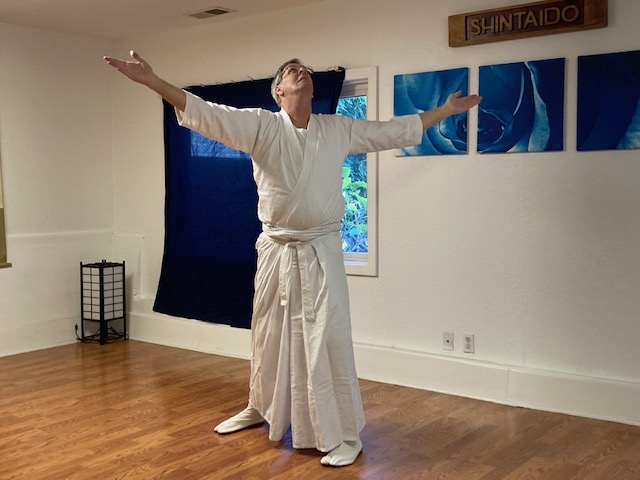by Robert Gaston
About the author
Many of you may have been fortunate to have had a chance to do keiko with Robert Gaston. He is a Senior Instructor of Shintaido and has practiced and studied for almost 40 years. He is a member of the International Technical Exam Committee (ITEC).
Rob initially studied Shintaido with John Seaman while he was at college in Oregon. When he left school, he joined the U.S. Navy and was stationed on the USS Enterprise aircraft carrier. He made part of this giant ship his dojo where he taught Shintaido to his colleagues.
He currently lives in the San Francisco Bay Area with his wife Sandra and daughter Sally both of whom practice Shintaido.
Rob teaches two classes a week; one Bojutsu and one Shintaido via Zoom. Please enjoy his movement and poetry.
This poem came to me at the end of a Zoom Master style class for the Global Taimyo Community taught by Clélie Dudon with Ito-sensei giving feedback.
She taught Taimyo part 3. Ito-sensei gave feedback to us all that focused on the Hoten-kyoku-ho. He expressed two important points, first focus on extending our reach in the bow, like a starfish encompassing and surrounding a sea urchin and second to feel ourselves being inflated from the outside, like the hairs on our entire body are being gently pulled.
I am not sure when I first learned the basic sequence of Hoten-kyoku-ho. It was probably at a Pacific Shintaido meditation workshop in the early to mid 90s.
Initially, it was a healthy body movement that helped ease my sore back after a lot of kaihokei Keiko. But when it was included in the Taimyo sequence and the subsequent Pacific Shintaido’s Taimyo workshop, it became one of the movements I began to feel connected, to others, to nature, to the universe, to something more.
It has had, like other Shintaido movements (i.e ,kirioroshi kumite) a multi-layer effect on my consciousness, peeling or cutting through levels of awareness. The effects and my awareness of Hoten-kyoku-ho have been gradual over many years and I have expressed my most recent “ah-ha” in this poem.
Thank you and please enjoy.

Hoten Kokyu Ho
(“Hugging Heaven”)
I bow and embrace, thank and acknowledge myself, body, present situation.
Turning to the right, I feel myself invited to expand my awareness to others
my family, friends, coworkers, those I struggle with.
I turn and face forward, changing my view point to face life directly.
I bow and embrace, thank and acknowledge them.
Turning to the left, I feel myself invited to expand my awareness to a greater community
the struggles we have with other viewpoints and cultures.
I turn and face forward appreciating the beauty and strength in diversity.
I bow and embrace, thank and acknowledge humanity.
Turning to the right, I feel myself invited to expand my awareness to Nature, ecosystems,
the biosphere, the earth, the struggle of survival, the cycles of life and death of all beings.
I turn and face forward changing my view point, Nature and I are inherently interlinked.
I bow and embrace, thank and acknowledge connection to nature.
I turn to the left. I feel myself invited to expand my awareness to the solar system,
the sun, the planets and all their moons, the space between and their cycles.
I turn and face forward changing my view point, I am affected by their cycles
their pull and tug keeping my world safe for life.
I bow and embrace, thank and acknowledge our solar system.
I turn to the right, I feel myself invited to expand my awareness to the Milky Way and all galaxies.
The star nurseries, nebulae, supernova and black holes.
I turn and face forward changing my view point, I am made of stardust and
all that is in the universe is in me.
I bow and embrace, thank and acknowledge the cosmos.
I turn to the left and I feel myself invited to expand my awareness to Ten.
I turn and face forward changing my view point, I am always in Ten and Ten is in me.
I bow and embrace, thank and acknowledge. I rise up to Ten Chi Jin posture.
Awareness.
Robert Gaston
6 November 2022




Nicely done Rob.
Here’s another poem for sharing- composed in the 1980’s by a former Worcester MA student. Sorry I can’t remember his name.
O, Kiai All Ye Faithful
A holiday guide to Tenshingoso
“UM” – Contemplative sound one makes when trying to decide on a gift for Aunt Sophie.
“AH” – Ecstatic sound when discovering none of the tree lights need replacing.
“AY” – Actual kiai from parents fighting for the last remaining Nintendo set.
“EE” – Translates loosely as “Oh no! Not another fruitcake”!
“OH” – Somewhat groan like sound made after overeating at holiday dinners.
Thank you Rob